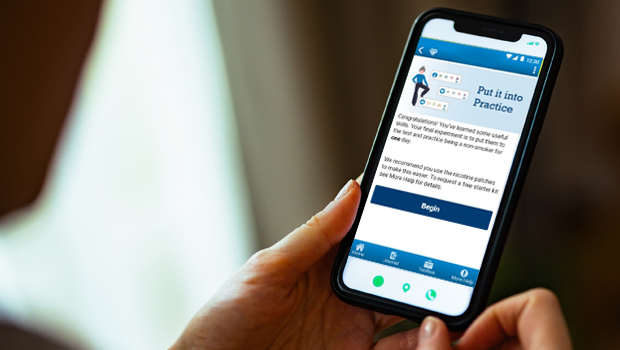Digital tool could help people change smoking habits

An app for ambivalent smokers is designed to help users build motivation for reducing or quitting smoking and increase confidence in their ability to change behaviors.
A mobile application designed to engage smokers who are ambivalent about quitting shows promising results
Cigarette smoking is the leading cause of death and preventable disease in the United States, according to the Centers for Disease Control and Prevention. Worldwide, tobacco use is the cause of more than 8 million deaths annually. New work from researchers at Kaiser Permanente Washington Health Research Institute (KPWHRI) shows promise for reaching a group of people who often don’t qualify for existing treatments — ambivalent smokers, or people who smoke cigarettes and want to quit someday, but aren’t yet ready to quit. The paper was published this month in JMIR mHealth and uHealth.
“Most of the stop-smoking interventions available today are designed specifically for people who are ready to make a quit attempt,” said Jennifer McClure, PhD, lead author of the paper. “We don’t have good support and tools for people who are ambivalent about quitting, which is about 70% of people who smoke. Without better tools and resources for this group, it’s going to be very difficult to reduce smoking in this country.”
The research team developed and pilot tested a mobile health app called GEMS. Participants were randomly assigned to either a standard care (SC) version of the app, which included basic advice to quit designed for people who are ready to make a quit attempt, or an enhanced version (EC), which included content and exercises designed for people who are ambivalent about quitting. Participants were receptive to both versions of the app, but as McClure and her team hypothesized, key outcomes trended in favor of the EC version. For example, a larger percentage of EC participants reported they had stopped smoking, accessed free counseling or nicotine replacement therapy made available to all study participants, or reported a quit attempt during the 3-month pilot.
“We have to be careful about drawing definitive conclusions about the EC app’s effectiveness since this was a small pilot study, but the results are encouraging,” McClure said. “The findings suggest people are willing to use an app designed to help them change their smoking behavior, even if they aren’t yet ready to quit. And some of these people will go on to stop smoking. If the results of this pilot are supported in a larger randomized controlled trial, GEMS could offer a low-cost, high-reach strategy to help more people quit smoking.”
Trial design
A total of 60 participants enrolled in the study, and 57 downloaded the app. On average, participants smoked 18 cigarettes per day. At the start of the trial, participants self-reported their motivation to quit smoking as well as their confidence in their ability to quit. On a scale from 1 to 10, average confidence was 4.1, while average motivation was 6.2.
Participants were randomly assigned to either the SC version of the app or the EC version. Both versions gave users access to evidence-based smoking reduction advice and resources, but the EC version included self-paced exercises based on motivation and behavior change theory. The exercises, called “experiments,” were designed to help users clarify their values, build and strengthen motivation for reducing or quitting smoking, and increase their confidence in their ability to change smoking behaviors by learning new behavioral skills like how to manage cravings without giving in to the temptation to smoke.
“We called them experiments,” McClure said, “because the goal was for people to try each exercise and just see what happens — what do they learn.” The idea came from ambivalent smokers the team interviewed while designing the app.
As study participants used their assigned app version (SC or EC), they earned reward badges. After earning 6 badges, they could request free nicotine replacement therapy to help them stop smoking. Participants could also connect with free smoking cessation counseling by clicking a button in the app.
"This is important because combining counseling and pharmacotherapy is the gold standard for helping people stop smoking,” McClure said. The app is designed to not only motivate and support behavior change, but also connect people with best practice, evidence-based treatment.
Encouraging results
After the 3-month pilot, both versions of the app received positive feedback from participants, with the majority saying they would recommend it to others. However, the EC version of the app had higher engagement from users. Participants using the EC version had an average of 19.9 sessions over 3 months, in comparison with 7.3 sessions for the SC group, and they earned more reward badges.
Motivation to quit smoking, as well as confidence in their ability to quit smoking, increased for both groups during the pilot, but EC users reported higher motivation to quit (8.3 on a scale from 1 to 10) than users of the SC version of the app (7.4 out of 10). At the end of 3 months, EC users completed an average of 6.9 of the self-paced exercises, out of 9 total. Researchers also asked EC participants to rate the helpfulness of each exercise. Exercises focused on learning to identify triggers for smoking, reducing daily smoking, and making a practice attempt at quitting received the highest ratings.
“A big question for us was whether people who used the EC version of the app would engage with the experiments, since they weren’t ready to quit smoking,” McClure said. “We found that over 90% completed the first experiment, and 61% completed the last experiment, which encouraged people to make a practice quit attempt. These preliminary results are encouraging and point to the value of conducting a larger study to test the effectiveness of the app.”
The majority of pilot trial participants had a household income under $45,000 annually. This is significant, the researchers said, because data shows that people who are socioeconomically disadvantaged are less likely to engage in treatment and successfully quit smoking. “Our ability to reach and engage this demographic group is also exciting,” McClure said.
Next steps
The research team is currently planning a larger randomized trial. If the results are consistent with this pilot, the GEMS app could fill an important treatment gap by helping people who aren’t yet ready to quit reduce or quit smoking.
“The detrimental impacts of tobacco use are substantial,” McClure said. “It’s important we develop new strategies to help everyone become tobacco-free. We hope GEMS will be one of many tools we can offer people in the future, to help them better realize their personal health goals.”
KPWHRI coauthors on the study are Chloe Krakauer, PhD, and Sophia Mun, MPH. External collaborators are Sheryl Catz, PhD; Jaimee Heffner, PhD; and Predrag Klasnja, PhD. This work was supported by a grant from the National Cancer Institute, with additional in-kind support for app development from Kaiser Permanente.
By Amelia Apfel
Smoking & Oral Health

Can a focus on better oral health help smokers quit tobacco?
Dr. Jennifer McClure partnered with the leading quitline provider to see what happens when smokers are counseled about oral health and tobacco.
research

Oral Health 4 Life: 10 years of research to improve smokers’ health and dental care
As Dr. Jennifer McClure completes the last of three innovative studies, she reflects on how the work began, the difference it may make, and what happens next.
healthy findings blog

Can being accepting and mindful help you stop smoking?
Tobacco remains a public health priority. Jennifer McClure, PhD, discusses her findings comparing ’acceptance and commitment therapy’ to standard care.


